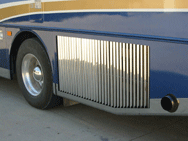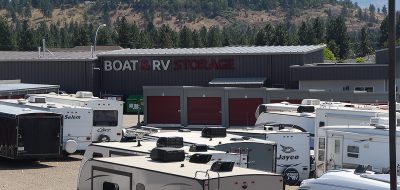Class “A” coaches are available with many options, but there are some things that can’t be changed. Depending on the make and model, you may get a rear mounted radiator or a side mounted unit. So, what is the difference?
Well, if you think one is better than the other, you might be wrong. Even though all high end coaches have side radiators and most of the entry level diesel pushers have rear, not cost, but specific design issues, may be the real reason. While there is no question that side mounted radiator systems cost more to build, we have to look at why they would be designed and used on larger engine equipped units. That is, on all diesel pusher engines in excess of 360 horse power.
These radiators consist of two main cooling sections, the charge air inter-cooler and the engine coolant. The charge air section has large internal tubing that cools the already boosted air pressure between the turbo charger and the intake manifold. The engine coolant section works similar to that of your automobile, that is, it keeps the coolant at a reasonable operating temperature. The larger the engine, the larger the radiator size has to be.
 Ideally the radiator works, design wise, best if it is mounted in the rear, directly behind the engine. This design requires less horse power to drive the cooling fan than does a side mounted cooling package. Additionally, some natural air movement, due to its location, is also a benefit. As far as blocking access to the engine from the rear, except for fan belt replacement, most DP service is performed from beneath or via the forward access panel. Radiator filling, oil checking, oil filling and transmission oil dipstick, are located usually at each side of the rad. This makes daily checks and fluids maintenance easily accessible.
Ideally the radiator works, design wise, best if it is mounted in the rear, directly behind the engine. This design requires less horse power to drive the cooling fan than does a side mounted cooling package. Additionally, some natural air movement, due to its location, is also a benefit. As far as blocking access to the engine from the rear, except for fan belt replacement, most DP service is performed from beneath or via the forward access panel. Radiator filling, oil checking, oil filling and transmission oil dipstick, are located usually at each side of the rad. This makes daily checks and fluids maintenance easily accessible.
So why then, do many motor coaches have side mounted radiators? Larger diesel engines require larger radiators to handle greater charge air volumes and adequate engine cooling. The width of the rear of coach body can not accommodate these larger cooling packages, while still providing fluid access points. The saw off point seems to be diesel engines with about 350 maximum horse power. This would leave Cummins ISB and ISC engines, along with Caterpillar C-7 and C-9 with the ability to use the rear rad. All larger engines require the cooling package to be remotely mounted to the side. This is not saying that all ISC or C-9’s are rear radiator equipped, as many can also be found with side mounted units. It is just approximately that size engines, however, it is up to the chassis builder as to which is used.
Okay, but what about the commonly thought short falls of rear rad set-ups?
Non-Clutched Fan – Granted most rear radiator equipped coaches employ direct belt driven fan assemblies. These generally do not have a thermostat controlled clutch, as apposed to the side mount. The overall average input energy requirements may well be lower than that of the side mount. This is due to the need to power the remote fan assemblies with either a hydraulic power system or a mechanical drive system. The hydraulic units are powered by an engine driven pump assembly. This in turn drives a hydraulic motor that rotates the fan blades. This is controlled through an electronic valve that varies the fan speed, usually two or so set speeds. The mechanically driven units must drive the cooling fan through two ninety degree configurations. Most, if not all of these, employ a thermostat controlled clutch. These are generally far more complex than one would imagine. They are activated by more than just engine coolant temperature such as, intake manifold temperature, transmission temperature, exhaust gas temperature and like. Some are driven through an electro-magnet field that increases field strength as temperatures rise and finally lock up an electric clutch at, or near, the high limits. Some of these side mounted fan drive assemblies can take up to 70 horse power to drive during peek demand/RPM scenarios.
 Radiator Fins Plug Up Causing Over Heat – Rear radiator equipped pushers tend to attract more dirt than side. This is due to the rear fan pushing the air from the engine compartment out, while side moves the air from out to in. The dirt build up on the rad core is caused be an oil film that can gather on the fins. Usually the majority of this oil comes from misting from the crank case ventilator tube (Also referred to as the “Slobber Tube”) This tube can be extended using a piece of hose eliminating this issue. Most such equipped coaches are already designed in this manner. The rear radiator does, however, still attract a little more dirt than the side. This is because of the motor being directly up wind which blows any engine sweat through it. Any build up within the radiator fins usually indicates a lack of regular cleaning. These must be washed periodically. This is a simple procedure using a product like Simply Green. Just spray it into the radiator core, let it sit, and rinse it out. Do not use a pressure sprayer as it may damage the cooling fins.
Radiator Fins Plug Up Causing Over Heat – Rear radiator equipped pushers tend to attract more dirt than side. This is due to the rear fan pushing the air from the engine compartment out, while side moves the air from out to in. The dirt build up on the rad core is caused be an oil film that can gather on the fins. Usually the majority of this oil comes from misting from the crank case ventilator tube (Also referred to as the “Slobber Tube”) This tube can be extended using a piece of hose eliminating this issue. Most such equipped coaches are already designed in this manner. The rear radiator does, however, still attract a little more dirt than the side. This is because of the motor being directly up wind which blows any engine sweat through it. Any build up within the radiator fins usually indicates a lack of regular cleaning. These must be washed periodically. This is a simple procedure using a product like Simply Green. Just spray it into the radiator core, let it sit, and rinse it out. Do not use a pressure sprayer as it may damage the cooling fins.
So, in analyzing the side radiator verses the rear, it would appear that both are best for their particular application. That is, if the coach weight and engine size can be handled by a rear mounted unit, it would probably deliver superior performance, and or economy, over an identical weight and powered rig employing a remote side mount. After all, chassis manufacturers know their business and are not about to produce an inferior product design, just to save money.
Well, in my book anyway, I think the side verses the rear radiator appears to be apples verses oranges. You can’t really compare them as they are different size applications, and each have their own benefits.
With A Cooling View – Lug_Nut – Peter Mercer






LouAZ
I just came back from a Used Class A motorhome dealer in Fountain Hills Az. We looked at a gas pusher Winnie and 3 different diesel pushers, all with rear center radiators. All four SUCKED AIR IN from the rear grill,thru the radiator, then the shroud, then the fan, and blew the air across the engine that went down and out. All four had the newer style nylon multiblade fan. We could tell which way the fan would blow or suck, by getting underneath and looking at which way the fan blade was curved. Then we confirmed the SUCK by running the engine, and feeling the air at the rear grill. Ducted fans/shrouds do not work both ways with the same efficiency. The shroud and close fitting fan hole are what allow airflow to be sucked across the whole radiator face, including the corners. If the airflow is reversed (which takes a REVERSE FLOW FAN , not just the fan turned around) then you can feel the air come “out” as a donut, and the corners and center are dead air. The shroud serves no real purpose in “reverse flow”.
Would you please review and confirm the actual airflow direction (Freightliner XC and Roadmaster Chassis is what we looked at) thru center mounted radiators in pusher Class As ?
Standing by. Thx, Lou.
Lug_Nut
Traveling Light 2, I am very pleased you find the articles of such help and for all the kind words. Thank you and all the best in your future motor home endeavor. Thanks for the input.
Traveling Light 2
Lug_Nut,
I am a diesel newbie. You have had several posts that I have found well written and educational. I am now going back over several of your old posts for additional information, they are definitely jewels of information. You have a great technical writing style that is informative and understandable. You and the comments from those reading your forum have been a gold mine of information for me.
My wife and I will be purchasing an older DP sometime this year and will be full timers from that point on.
Your information on radiators has been very helpful. Thanks
Lug_Nut
Skip Aldrich, Excellent point. In fact I make it a habit to peak through the rear vent slots each time I stop along the way. Just to see if there are any leaks or something not right. With a rear rad this would not be able to be done, certainly as easy anyway. Thank you for taking the time to comment and for your welcomed input.
Skip Aldrich
One additional disadvantage with a rear radiator is an obstructed view of the engine and the engine compartment. I like to be able to inspect for loose bolts, brackets, and falling wire looms. While I may not want to fix them myself, Spoting problems before they cause a failure can save time and trouble on the road.
Lug_Nut
merrill rininger, I can’t imagine no coolers. The tranny is probably cooled internally similar to an auto. That is a heat exchanger inside the rad. The oil, probably has no cooler. Thanks for all the great input.
merrill rininger
A friend of mine bought a new 26ft class C, with no coolers, tranny or oil, my Apollo has both, I thought something is wrong, with that much weight and no coolers, won’t that shorten the life of the rig. We don’t know for sure, better to ask?
merrill rininger
Anyone buying a used MH that has a spare tire, make sure they come with the jack. For thoes of us that can do it our self, should have the %^$#& jack! It was my falt for not thinging that all MH natuarly come with stuff like that. Don’t be a dummy like me, check the small things, it really matters! thank you!
merrill rininger
I have a 79 Apollo 33ft with a rad. behind the right rear tires. My question is how do I tell if two 8″ fans turn on.There is no switch ,so I asume its thermo operated, but I cant drive and see the rad. at the same time. I always wondered what that goofy looking thing was! Thank you!
John
Rich D.
.It’s a great feature and functional too as you know. It shouldn’t be hard to install a switch but, manufacturers should realize their value and wire them into the build process. Thanks for the info on the Wanderlodge equipped with this fan o/r switch.
If I remember correctly, Blue Bird makes the Wanderlodge and obviously learned the value of this override switch after building buses for years.
Rich D.
John,
YES, some do come with a “Fan Over-ride” switch. My Wanderlodge has this switch and I activate it after hard use and I anticipate shutting down. Turning it on a few miles before the rest area cools the engine dramatically so a lot of the heat is gone before I shut the engine down. I don’t see why a switch could not be inserted into the circuit that Lug mentioned and routed to your dash.
John
Forgot to mention the article I read last year in an RVing magazine, about the problems that plagued some of the aluminum radiators on coaches. Apparently, the transmission cooler was inside the radiator whcih, on some, developed a leak and caused some transmissions to fail. Both the cooalnt and trans oil had to be flushed and replaced after repairs were done.
I beleive that some of the coach manufacturers issued a recall. The problem was corrected at the radiator manufacturers’ plant. Otherwise aluminum rads work great. Thanks for the tip on Simply Green, I’ll have to try it when the new coach is serviced. I usually place a piece of screen mesh between the grill and rad core to help keep debris out. It’s very inexpensive and easy to install.
Cheers,
John
Lug_Nut
Hi John, I don’t think any comany has offered a remote switch to engage the fan on a motor coach. On mine there is a plug in the wiring harness to the right of the compressor. If you unplug that particular wire, the fan will engage and run full time. By disconnecting it, it simulates a power loss, which “failsafe” automatically engages it. Thanks for your great input.
John
Hi Lug_Nut,
A Very informative article. I used to have a fan override switch in my highway tractor that would enable me to increase cooling before going up steep pulls in hot weather. It helped a lot. Is this feature available on the larger HP coaches?
Cheers,
John